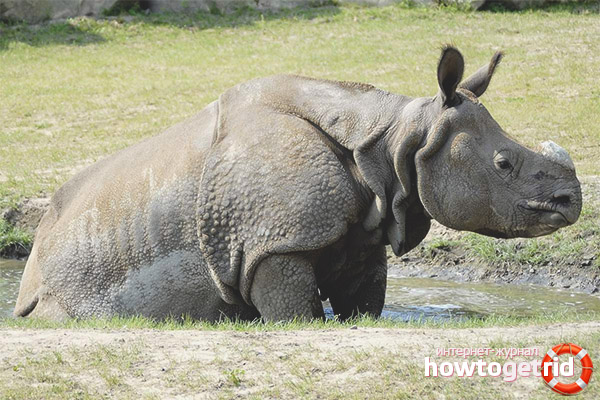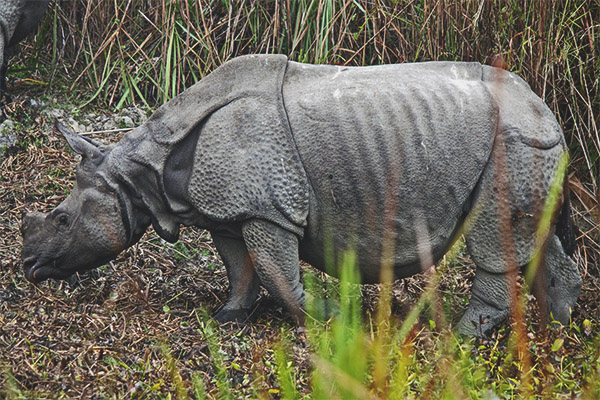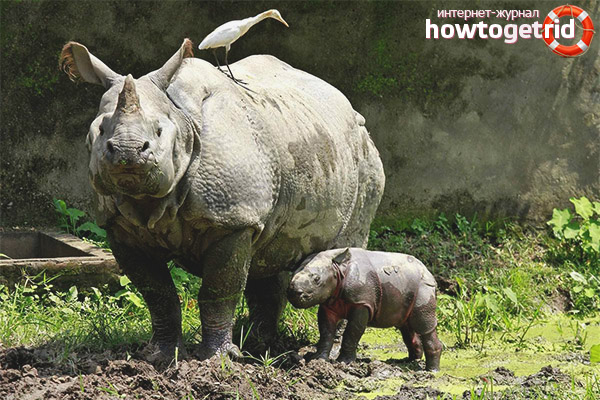The content of the article
If you translate the name of the Indian rhino from Latin - it will sound like “one-horned rhinoceros”. Sometimes representatives of this species are also called armored rhinos. On the territory of Asia you can find only one species that will exceed the size of the Indian rhinoceros. This is an elephant. This species is the largest in comparison with other species of rhinos living in Asia.
Appearance
Indian rhinos are very large animals. Sometimes their weight can reach 2500 kg. Males can have a height of up to 2 m. Females, on the other hand, have slightly smaller dimensions. The horn of representatives of this species can reach a length of approximately 25 cm. But in some individuals it can be up to 60 cm. But such a horn can be seen only in males. In females, it is quite small and looks more like a bump.
These animals have no wool.They have pinkish-gray skin. Its surface is divided into areas by folds. Therefore, it looks like shells. That is why one of the species names is “an armored rhinoceros”. It is quite difficult to determine what color the surface of the animal's skin has. Vedas, they often like to lie in the mud, after which it remains on them as a whole layer.
On the ears, as well as on the tail of the animal there are small tassels. On the paws they have 3 fingers. On the shoulders of the rhino there is a deep fold. They have small eyes. Upper lip curved towards the bottom. And on the lower jaw there are very powerful incisors, which often serve as a weapon for the rhinoceros.
These animals are very strong and large. But they look like clumsy heavyweight wrestlers. Such an external impression is deceptive. In fact, rhinos have a fast response, they are quite mobile. If danger approaches, the Indian rhino can accelerate to a speed of 40 km / h. They have excellent hearing and keen sense of smell. Due to this, already at a distance of several hundred meters the rhinoceros will understand that there is a predatory animal or man. But at the same time their eyesight is rather weak.
Nutrition
Where dwells
A few centuries ago, representatives of this type of mono were found almost everywhere in the south of Asia and China. They lived in the eastern part of Iran. But the number and habitat was significantly influenced by human activity. They were hunted a lot, their habitat was destroyed. In almost all these regions, the number of rhinos has decreased significantly. After colonization by Europe, Indian rhinos remained only in reserves. The number was also influenced by a large number of hunters who used firearms. In addition, the territory of the jungle has steadily decreased as a result of the intensive growth of the Asian population.
Today, representatives of this species live in southern Pakistan.They can also be seen in eastern India, and Nepal. Some animals live in the north of Bangladesh. The territories on which rhinos live are very strictly protected today. There are not so many individuals left in the world. The most numerous population is in the state of Assam. This is the territory of India. Animals live in the territory of the national park called Kaziranga. About 1600 animals live here. This is about 2/3 of all representatives of the species in the world. About 600 individuals live in Nepal’s Chitwan Park. About 300 rhinos mono see also in one of the parks of Pakistan. Today, researchers say that about 2.5 thousand Indian rhinos live in the world. Their numbers are growing.
In the Red Book, this species is listed as vulnerable. But the Sumatran as well as Javanese species are in a more disastrous situation.
The closest species is considered Javanese rhinoceros, which also belongs to the genus Indian. Their body length reaches about 3 m, they grow to a height of 1.6 m. They have 1 horn, which grows up to 20 cm. This species is very rare. In total, there are about 60 representatives. In captivity to contain them does not go.
Sex differences
Females horn is much less pronounced, they are not as large as males.
Behavior

These animals prefer loneliness. Each representative chooses for himself a territory of about 4 thousand square meters. m. In this area will surely grow elephant grass, there will be located a puddle of mud, as well as a bigger lake or the coast of a larger reservoir. With the help of manure, the males, as a rule, mark their possessions.
You can see a lot of paths in the thickets themselves, where a lot of elephant grass grows. They are trodden by rhinos. Among them there are common, in which animals make their way to the puddles. But there are also personal paths that the rhino protects from others.
These animals, although they have a huge weight, swim beautifully. They can swim across a wide river or lake.
They do not make loud piercing sounds. If you disturb the Indian rhino, you can hear a sound like snoring. The female covenant their offspring grunting. And when there is a marriage period, its sound is like a whistle. Grunting can also rhinos during the search for food. But if one of them is injured or feels a particular danger, they will emit a loud roar.
Rhinos are usually very aggressive. If an individual is annoyed, it can also be thrown at the elephant. They can even attack for no apparent reason, so they should not be approached by these animals.
When the Indian rhino attacks, it does not use a horn, but its powerful incisors. In this way they inflict very deep wounds.
Breeding
In captivity, animals live up to 70 years, and in nature are usually less.
Enemies in nature
Predatory animals do not attack them. Tigers can sometimes be attacked, but only on toddlers, as the tiger cannot defeat this animal in a battle. They are not afraid even of elephants, fearlessly rushing at them. The elephant usually leaves.
The most troubles to these animals are various parasites. This lice, ticks. From them only birds help.Juveniles suffer from helminthic invasions.
Interesting Facts
- Birds usually live near rhinos. This herons, and bee-eaters, and starlings. They hunt insects, which makes the rhinoceros fly. Birds also feed on insects that live on the animal's skin.
- It was this species that was the first of all rhino species that people from Europe saw. For the first time among them, this animal was depicted by Durer. It was an engraving called the "Rhino". The artist created this work without seeing the animal. The rhino here looked somewhat wrong. And in 1513 the animal was taken to Lisbon. It was a gift from the Rajah to the King of Portugal. Then it was Manuel I. The animal was put on display as a curiosity for the people, after which it was sent to the Pope. It was supposed to be a gift, but he did not get to the destination. The ship sank as a result of the storm.
- Indian feudal lords entertained, hunting for rhinos. This can be judged by the miniatures that have remained since the 16th century. They are representatives of the Mughal dynasty prey on these animals, sitting on elephants.
- Most of the damage to this species caused the hunt for rhinoceros.There were legends that the horn of an animal has great power. The people of Asia were convinced that this was a very good aphrodisiac, as well as a real salvation against poison. Even today on the black market the horn of this animal is very expensive. It is usually sold to poor Asians who want to get rich in this way. But in India there are many laws that strictly protect these animals from poachers.
Video: Indian rhino (Rhinoceros unicornis)












To send